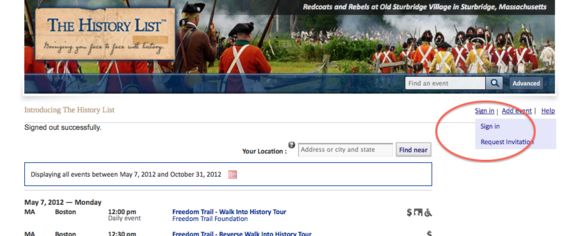We opened (quietly) late last week so that other organizations can begin to participate. This follows a six-month beta that included The Freedom Trail Foundation, Historic New England, the Bostonian Society, the USS Constitution Museum, and several smaller historical societies (including the Marlborough Historical Society in Massachusetts) and museums (incl. the Smith-Appleby House Museum in Smithfield, RI and the Adirondack Museum in New York) as well as other organizations (incl. the Vine Lake Preservation Trust in Medfield, Massachusetts).
Thanks to Matt, Rob, Samantha, and Jodie for jumping in with both feet from the get-go, listing their events, and providing feedback throughout, and to everyone we talked with who provided suggestions and encouragement. And to Deb and Ann at Old Sturbridge Village who told us within a few hours of opening that they will list all of Old Sturbridge Village's events.
Getting started is easy:
Request an account if you don't have one already. Sign in if you do. And don't worry, if you've forgotten your password, just click on "Sign in" and you can recover your password. (See the screenshot to the right.)
Enter information on your current and upcoming events and exhibits—Entering information is cut-and-paste simple, all of the formatting is maintained, and you have essentially unlimited space for a description and for pictures.
And because anyone who has an account and is signed in can add or edit information, organizations have a lot of flexibility with adding and updating their information. Large organizations can have a summer intern or have a few different staff members enter and update information.
Smaller organizations may wish to ask a volunteer to add the information. This may even be the right approach for some very large organizations, such as those with a formal "friends" group or a large number of docents who handle events or give tours.
Updated: May 12, 2012: Use this one-pager as a guide.
Enter information about your organization or site—Similar to entering information about your events, entering information about an organization is quick and easy. And all of the events from the organization will show up automatically at the bottom of the organization's page.
For the typical smaller organization with ten events, it should take roughly 30 minutes to enter the information about the events and to set up the organization's page. This means that, once a year, an organization can publicize their events to anyone anywhere for an investment of 30 minutes time.
Questions? Feedback? Let us know.
